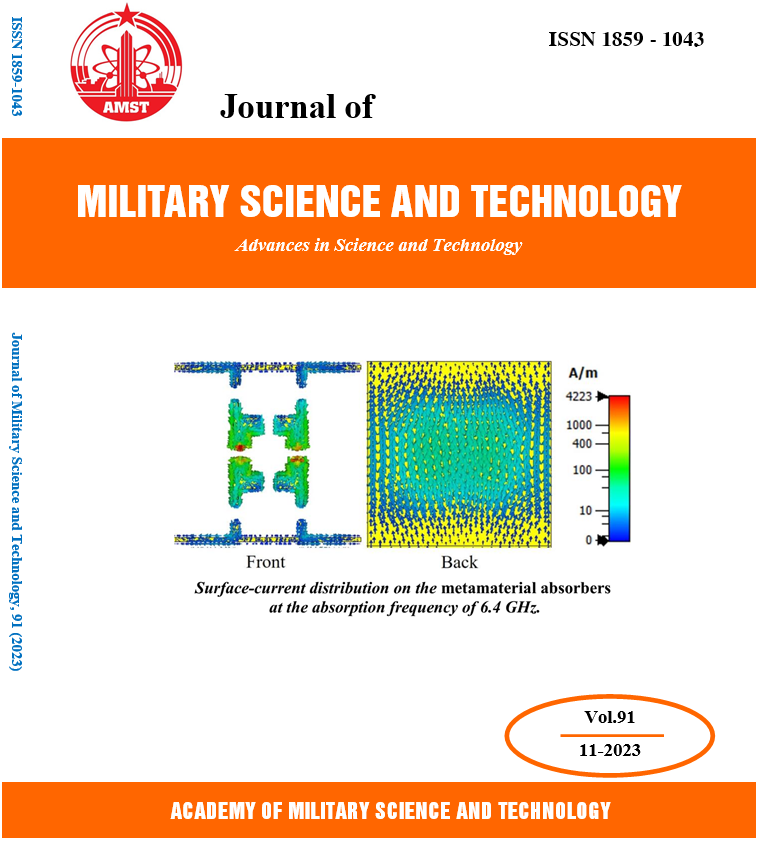Implementing PGD technique in solving the problem of identifying Young's modulus of linear elastic isotropic material from full-field measurements by FEMU method
347 viewsDOI:
https://doi.org/10.54939/1859-1043.j.mst.91.2023.96-106Keywords:
Material parameter identification problem; Finite element method updating (FEMU) method; Proper generalized decomposition (PGD) technique.Abstract
This paper deals with implementing Proper Generalized Decomposition (PGD) technique in solving the problem of identifying Young's modulus of linear elastic isotropic material from full-field measurements by finite element model updating (FEMU) method. In this type of problem, using PGD technique enables reducing the computation cost as it helps to avoid performing the iterative process of computing the response of the mechanical structure by finite element method (FEM). The nature of PGD technique consists following important points: (i) – interested parameters are considered as extra variables for the response function; (ii) – sought multidimensional response function is approximated by the finite sum of modes, each is production of separated-variable functions; (iii) – This approximate solution is computed by the iterative solver using a variational formulation and a greedy algorithm. A numerical example of a tensile test was performed to verify this implementation. The obtained results confirm the correctness of PGD technique. Several comments were made on the use of this technique.
References
[1]. Cailletaud G. and Pilvin P., “Identification and inverse problems related to material behaviour”. In H.D. Bui, M. Tanaka, and al., editors, Inverse Problems in Engineering Mechanics (1994).
[2]. Rastogi PK, “Photomechanics”, Springer, Berlin (1999). DOI: https://doi.org/10.1007/3-540-48800-6
[3]. Sutton M., “Computer vision-based, non-contacting deformation measurements in mechanics: a generational transformation”, Applied Mechanics Reviews, 65(5):050000, (2013). DOI: https://doi.org/10.1115/1.4024984
[4]. Hild F. and Roux S., “Digital image correlation”, In “Optical Methods for Solid Mechanics. A Full-Field Approach”, Wiley, pages 183–228, (2012).
[5]. Avril et al., “Overview of identification methods of mechanical parameters based on full-field measurements”, Experimental Mechanics, 48:381–402, (2008). DOI: https://doi.org/10.1007/s11340-008-9148-y
[6]. Hai Nam Nguyen et al, “mCRE-based parameter identification from full-field measurements: Consistent framework, integrated version, and extension to nonlinear”, Computer Methods in Applied Mechanics and Engineering, Volume 400, 115461, (2022). DOI: https://doi.org/10.1016/j.cma.2022.115461
[7]. Pagnacco E. et al., “Inverse strategy from displacement field measurement and distributed forces using FEA”. In “2005 SEM annual conference and exposition on experimental and applied mechanics”, Portland, (2005).
[8]. Chatterjee A., “An introduction to the proper orthogonal decomposition”, Current Science, 78(7):808–817, (2000).
[9]. Maday Y. and Ronquist E., “A reduced-basis element method”, Comptes-Rendus de l”Académie des Sciences, I, Paris, 335:195–200, (2002). DOI: https://doi.org/10.1016/S1631-073X(02)02427-5
[10]. Chinesta F. et al., “The proper generalized decomposition for advanced numerical simulation”, Springer, (2014). DOI: https://doi.org/10.1007/978-3-319-02865-1
[11]. Chinesta F. et al., “Recent Advances and New Challenges in the Use of the Proper
Generalized Decomposition for Solving Multidimensional Models”, Arch Comput Methods Eng 17: 327–350, (2010). DOI: https://doi.org/10.1007/s11831-010-9049-y
[12]. Hasini Garikapati, “A Proper Generalized Decomposition (PGD) approach to crack propagation in brittle materials: with application to random field material properties”, Computational Mechanics 65:451–473, (2020). DOI: https://doi.org/10.1007/s00466-019-01778-0
[13]. P. Z. Qin, “Finite Element Modeling and PGD Based Model Reduction for Piezoelectric & Magnetostrictive Materials”, Doctoral Thesis, Université Pierre et Marie Curie, (2016).
[14]. K. El-Ghamrawy, S. Zlotnik, “Proper generalized decomposition solutions for composite laminates parametrized with fibre orientations”, Comput Mech 71, 89–105, (2023). DOI: https://doi.org/10.1007/s00466-022-02218-2
[15]. M. El Fallaki Idrissi, “Multiparametric modeling of composite materials based on non-intrusive PGD informed by multiscale analyses: Application for real-time stiffness prediction of woven composites”, Composite Structures, Volume 302, 116228, (2022). DOI: https://doi.org/10.1016/j.compstruct.2022.116228
[16]. Allier P. E. et al, “Proper generalized decomposition computational methods on a benchmark problem: introducing a new strategy based on constitutive relation error minimization”, Adv Model Simul Eng Sci. 2(17), (2015). DOI: https://doi.org/10.1186/s40323-015-0038-4
[17]. P. E. Allier et al., “Towards simplified and optimized a posteriori error estimation using PGD reduced models”, Int J Numer Meth Engng. 113:967–998, (2018). DOI: https://doi.org/10.1002/nme.5695







